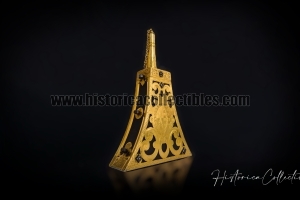Pulverflasche/Powder Flask of the Guard of a Prince Elector of Saxony Christian I, circa 1586
Powder Flask or Pulverflasche (gunpowder holder for arquebus) made in 1586 and belonged to one of the 100 personal guards of Christian I, Elector of Saxony and member of the House of Wettin, (1560-1591).
This sumptuous flask is made up of a trapezoidal wooden element covered in black silk on which a structure made up of some finely carved, engraved and completely gilded brass plates is applied using some screws which make its appearance spectacular; the terminal element useful for inserting the powder into the blunderbuss is equipped with a carefully finished cap held in place by a safety chain.
The lever with the spring mechanism relevant to the dosage of the powder, the screws, the hooks for the shoulder strap and the belt, are all made of steel perfected with a blue burnishing.
It is believed, in all probability, that the Guards of Honor maintained the same uniforms including powder flasks, even when Christian II of Saxony was appointed Elector who succeeded his father Christian I in 1591 at the age of just eight. For this reason, one of his father's trusted men, Duke Frederick William I of Saxe-Weimar, assumed the regency of the electorate for him until 1601, the year in which Christian II, having reached the age of majority, was deemed fit to govern. He remained in office until 1611.
Such was the splendor of these magnificent flasks that in 1719, on the occasion of the marriage of the Elector Prince Friedrich August II with the Austrian Kaiser's Daughter Maria Josepha, they were reused to decorate the uniforms of Friedrich August II's Honor Guards.
Specimen of extraordinary historical importance, rarity and executive quality, splendid state of conservation.
The flask is accompanied by an important and detailed Oplological Expertise drawn up by a Historical Expert of Ancient Weapons.
Some specimens are preserved and exhibited respectively:
- Metropolitan Museum of New York (Accession Number:28.195.3).
- Staatliche Kunstsammlungen Dresden (Inventory number:X0856 - X0852 - X0864 - 0876).
- Philadelphia Art Museum (Accession Number: 1977-167-899).
- The Military Historical Museum of Artillery of St. Petersburg.
- Peter Finer "Arms and Armour from the Court of the Electors of Saxony 1580-1625" Published on Feb 15, 2017.
References:
Grancsay, Stephen V. "A Gift of Powder Flasks. The Metropolitan Museum of Art Bulletin, (May 1929), p. 133, fig. 5.
Peterson, Harold L. The Treasury of the Gun. New York: Golden Press, 1962. p. 44.
Nickel, Helmut. Ullstein-Waffenbuch: eine kulturhistorische Waffenkunde mit Markenverzeichnis. Berlin: Ullstein, 1974. p. 231.
Grancsay, Stephen V., and Stuart W. Pyhrr. Arms & Armor: Essays by Stephen V. Grancsay from the Metropolitan Museum of Art Bulletin 1920–1964. New York: The Metropolitan Museum of Art, 1986. pp. 43–46, fig. 14.4.
Christian I of Saxony (Dresden, 29 October 1560 – Dresden, 25 September 1591) was Prince-Elector of Saxony and member of the House of Wettin.
He was the sixth child, but the second surviving child of Elector August I of Saxony and Anna of Denmark. The death of his older brother Alexander (8 October 1565) made him the new heir to the Electorate of Saxony.
Christian succeeded his father upon his death in 1586. His chancellor was Nikolaus Krell. During his reign the first land registry of the Electorate of Saxony was created by Matthias Oeder. Oeder's work was subsequently continued by Balthasar Zimmermann until 1633 and completed as far as possible.
Marriage and heirs:
In Dresden, on 25 April 1582, Christian I of Saxony married Sophia, daughter of the Elector John George of Brandenburg, with whom he had seven children:
Cristiano (1583-1611);
Giovanni Giorgio (1585-1656);
Anna Sabina (born and died in 1586);
Sofia (1587-1635), married Francesco of Pomerania;
Elisabetta (1588-1589);
Augusto (1589-1615), married Elisabetta of Brunswick-Wolfenbüttel;
Dorotea (1591-1617), abbess of Quedlinburg.




